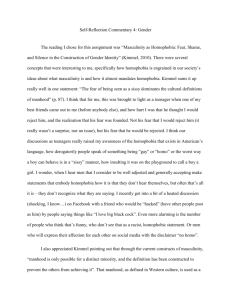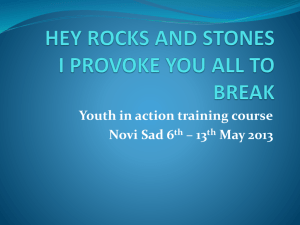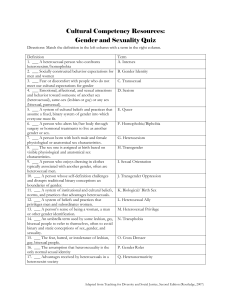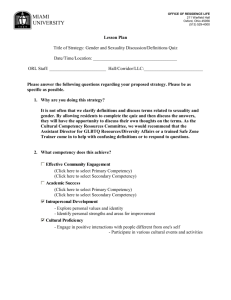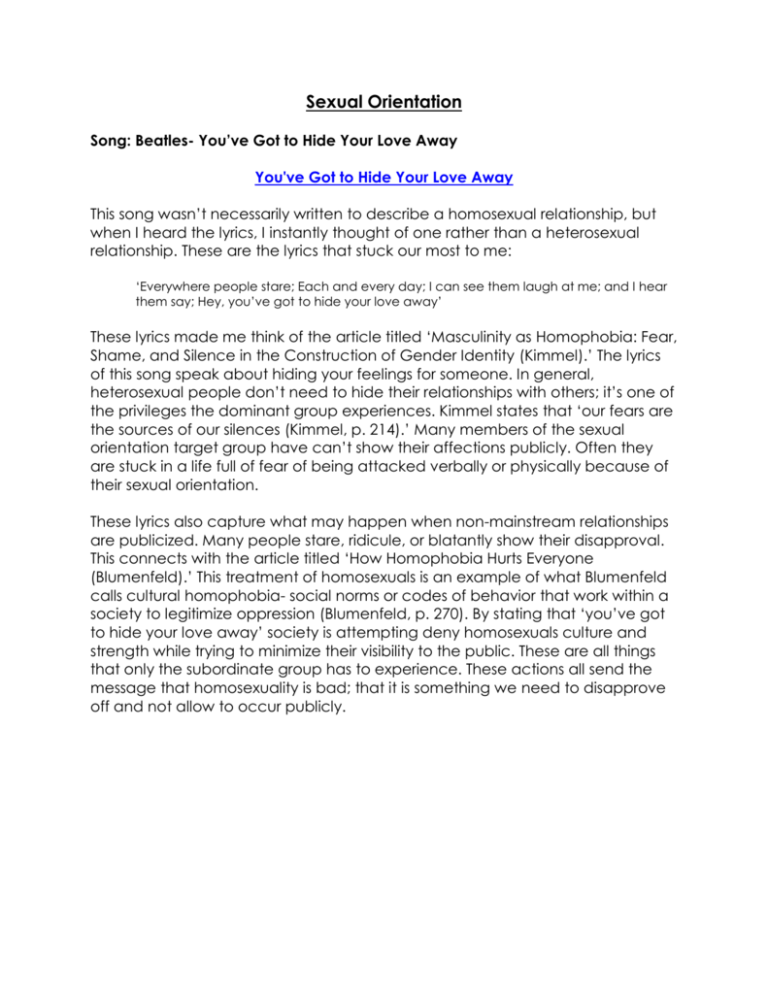
Sexual Orientation
Song: Beatles- You’ve Got to Hide Your Love Away
You've Got to Hide Your Love Away
This song wasn’t necessarily written to describe a homosexual relationship, but
when I heard the lyrics, I instantly thought of one rather than a heterosexual
relationship. These are the lyrics that stuck our most to me:
‘Everywhere people stare; Each and every day; I can see them laugh at me; and I hear
them say; Hey, you’ve got to hide your love away’
These lyrics made me think of the article titled ‘Masculinity as Homophobia: Fear,
Shame, and Silence in the Construction of Gender Identity (Kimmel).’ The lyrics
of this song speak about hiding your feelings for someone. In general,
heterosexual people don’t need to hide their relationships with others; it’s one of
the privileges the dominant group experiences. Kimmel states that ‘our fears are
the sources of our silences (Kimmel, p. 214).’ Many members of the sexual
orientation target group have can’t show their affections publicly. Often they
are stuck in a life full of fear of being attacked verbally or physically because of
their sexual orientation.
These lyrics also capture what may happen when non-mainstream relationships
are publicized. Many people stare, ridicule, or blatantly show their disapproval.
This connects with the article titled ‘How Homophobia Hurts Everyone
(Blumenfeld).’ This treatment of homosexuals is an example of what Blumenfeld
calls cultural homophobia- social norms or codes of behavior that work within a
society to legitimize oppression (Blumenfeld, p. 270). By stating that ‘you’ve got
to hide your love away’ society is attempting deny homosexuals culture and
strength while trying to minimize their visibility to the public. These are all things
that only the subordinate group has to experience. These actions all send the
message that homosexuality is bad; that it is something we need to disapprove
off and not allow to occur publicly.
Print Advertisement: Macy’s Jewelry
One way institutional homophobia oppresses homosexuals is through laws that
deny same sex marriage (Blumenfeld, p. 269). There are very few states that
allow same sex marriages, and many states that don’t acknowledge same sex
marriages (that occur in a state that allows them to happen). This connects with
cultural homophobia as well. Cultural homophobia consists of several categories
including fear of over visibility (Blumenfeld, p 270). By denying same sex
marriages, states may be trying to reduce the visibility of members of the
homosexual community in our society.
I chose this print advertisement because it sends a positive message. The two
rings advertised are the typical style of male wedding bands, suggesting a
homosexual relationship. One of the stereotypes surrounding homosexuals is that
they are promiscuous and don’t form lasting relationships. This advertisement
conveys the message that two people of the same sex can love each other.
Television Commercial: Pepsi Commercial
Pepsi Commercial
This artifact connects with the article titled Heterosexism, Homophobia, and the
Culture of Schooling (Friend). Friend defines heterosexism as the assumption that
everyone is heterosexual, or if not should be (Friend, p. 139). This can be seen in
the way the two males respond to their male friend leaving to go talk to another
male. They are shocked when he walks past not one, but two women, to get to
a man. This showed that they assumed their friend was heterosexual. Friend also
states that heterosexism is the arrangement that necessitates ‘coming out’
(Friend, p. 140) This aspect of heterosexism is seen in the commercial too. If the
men hadn’t simply assumed their friend was a homosexual they wouldn’t have
been so shocked that he passed by the women for the man. The use of older
individuals in this commercial also shows that coming out can be a lifelong
process.
This commercial sends the message that homosexuals have similar lives to
heterosexuals. They partake in the same activities, and can be friends with
people of different sexual orientation than themselves. The commercial does a
good job of portraying a ‘normal’ group of men having a good time.
Reflection Essay
Each of these pieces made me think of cultural homophobia, specifically
the fear of over visibility. These artifacts were not easy to collect; it was hard to
find something that portrayed some kind of message related to sexual
orientation. A trend of hiding a homosexual orientation was seen throughout the
tree artifacts. The song was rumored to be about a homosexual relationship but
this was never confirmed or denied. The Macy’s print advertisement required a
bit of searching for. The Pepsi commercial was actually banned from TV for
promoting a certain type of lifestyle.
This project has also made me aware of how un-accepting our society is
of homosexuals. Every commercial I found that could in some way represent a
homosexual individual or relationship was banned. Even though the only
difference between these commercials and others were that they portrayed
same-sex relationships, they were still banned. This shows just how strong
heterosexism is in our society.
This project has made me more aware of how privileged I am as a
heterosexual. In all types of media, I can find things to relate to. There are songs,
print advertisements, and commercials that describe my relationships. When I
see media portraying heterosexual relationships like mine, I can also be
confident that it isn’t negatively. This project has increased my awareness of
many of the privileges I receive just because I was born a certain way.
References
Friend, R. A. (1998). Heterosexism, homophobia, and the culture of schooling. In
S. Books (Ed.) Invisible children in the society and its schools (pp. 137-166).
Mahwah, NJ: Lawrence Erlbaum Associates. (Found in Dickens, Spring
2011, section 13)
Kimmel, M. (2000). Masculinity as homophobia: Fear, shame, and silence in the
construction of gender identity. In Adams et el. (Eds.), Readings for
diversity and social justice New York: Routledge Press. (Found in Lewis,
Spring 2011, section 15)
Blumenfeld, W. J. (2000). How homophobia hurts everyone, (pp. 267-275).
(Found in Dickens, Spring 2011, section 13)


